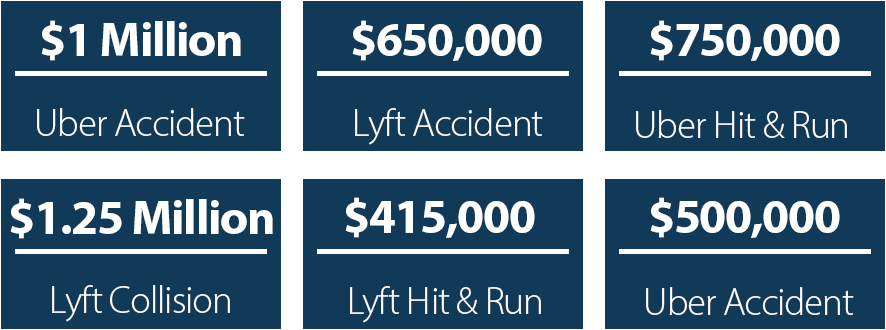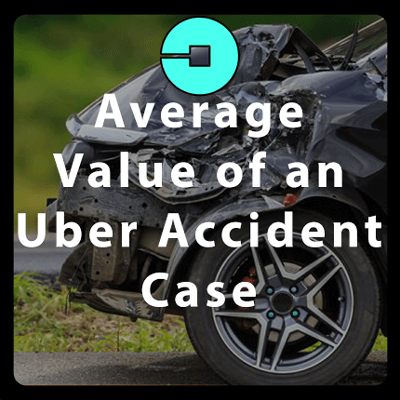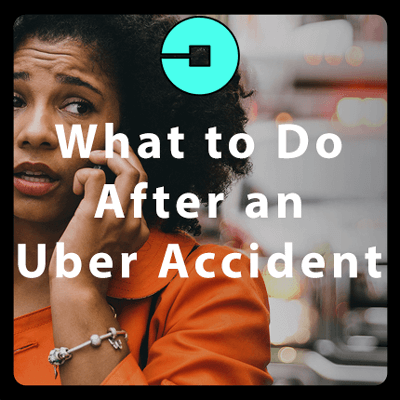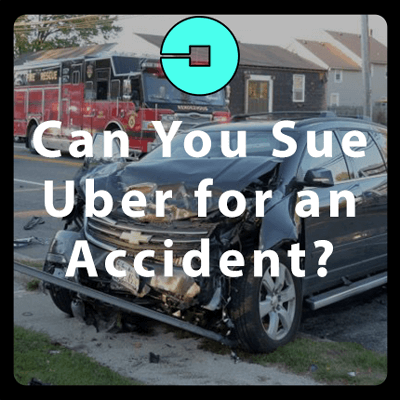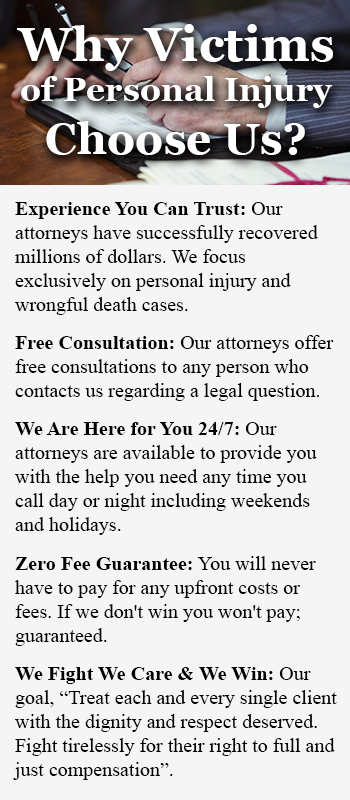If you were injured in an accident involving an Uber or Lyft vehicle, here is how the insurance policy works. First, if you’re a passenger in any of the services, you are covered by the policy for $1 million dollars. If the car you were in was at fault, Uber’s own insurance policy will cover you. However, if the vehicle you were in was not at fault, you would have an independent claim against the person who hit you. However, even if that person has a low policy, you will still have access to the $1 million dollar Uber insurance policy. This works much like your uninsured or underinsured motorist coverage. Uber insurance will protect you even if the person that hit you does not have insurance.
Now if you’re a driver you will also be covered by the policy. First, you would have access to the insurance policy provided to you by Uber. This policy, much like the passenger’s policy, will allow you to recover up to $1 million dollars for your injuries. However, if you’re at fault you will not have access to such a policy if you were the driver. Uber also has another policy for drivers depending on what stage of the pick up they were in. If the driver has his app on but has not yet picked up a passenger, he will be entitled to coverage up to $250,000 for the injuries hehas sustained.
Also, remember that in order for your policy to kick in as a driver, you must have active collision coverage. This is a strange element of Uber’s policy, which requires that you have this element of the policy active in order to have access to the policy.
If you were hurt in an Uber, Lyft, or other rideshare accident, you may be entitled to recovery for your injuries. Each of these cases is very specific and requires that you properly pay attention to very small details. Our top-rated law office, Normandie Law Firm, has handled a great number of Uber cases and we would be interested in hearing from you. All of our cases are handled on a contingency no recovery no fee basis. Call today to speak to a top lawyer experienced in rideshare accident cases.
Steps to Take to File a Claim: Below are important steps you should follow after an auto accident involving an Uber, Lyft, or other rideshare vehicle. These steps should be taken in an ideal situation, but if you fail to follow some of these steps, that does not mean that your case is ruined. You can still contact our qualified attorneys with experience in rideshare accident cases to find out what we can do for you. The steps are:
- Contact the police department and file a traffic accident report.
- Then, contact the rideshare company’s app and report the accident.
- At that point, the rideshare company will send you a reference number or the insurance company of the rideshare company will contact you. If this happens, ask for the claim number attached to the case.
- If an insurance adjuster contacts you in person or via email, do not speak with them regarding your injuries or medical treatment. Do not answer their questions regarding the accident. Any comments can be used in the future to reduce your recovery.
- Seek legal consultation from an expert attorney who has experience handling rideshare accident claims. Most accident law firms are not aware and do not have the experience necessary to handle an Uber or Lyft accident claim. Make sure you speak with an experienced in these cases.
Common Causes of Accident Caused by Uber and Lyft Drivers
There can be numerous causes of accidents involving Uber, Lyft, and rideshare vehicles. Some of the most common are provided below:
Distracted Driving
Uber drivers are in the business of making money. In order for them to make a good return on each ride, they must have either a long ride or multiple parties in the car, as more people equals more money per ride, which nets the driver a higher return. Multiple persons in a car generally happens when you take or use the Uber Pool service.
Here is how the system works. Uber’s app will notify the driver if other riders are heading in the same direction. If the app identifies that you’re in the same route or path as the current occupant of the vehicle, it will send a notification to the driver. In turn, the driver will pick up the passengers and they will join your ride.
What often distracts the drivers is constantly looking at the app/phone for updates. In order to pick up the ride, you must select that you will be doing so. In such cases, the drivers will have to pay attention to the phones in order to make sure they are not missing any notifications. The problem becomes compounded when you have other applications running in a vehicle.
Thus, in order for the drivers to make money off the rides, they will need to pick up as many passengers as possible. This constant attention to the road will cause the driver to be distracted and increase the likelihood of an injury.
The Speedy Driver Problem
Again, you have drivers who are under pressure to provide more rides. In order to meet this demand for volume, they will need to pick up as many passengers as possible. Just like everyone else, they have a limited amount of time in the day. In order to maximize the value of their time, they need to make sure they have as many rides as possible.
In order to achieve this, drivers will have to ferry riders to and from locations as quickly as possible. Often times they will have little to no sleep and will drive at late hours of the night. Due to the way Uber’s surge works, certain hours of the night or certain days of the week will have a surge. Surges allow Uber drivers to make more money per ride, so in certain cases, you will have drivers who are picking up passengers in the middle of the night to collect the surge payment.
This becomes a problem when you have a tired driver who is not able to properly maneuver. Often times, the reflex times and the ability of the driver to handle the incident are compromised due to lack of sleep.
Seeking Legal Help – What We Can Do
An auto accident can result in many unforeseen issues. Victims are often unaware of their rights and how to maximize the potential value of their case. Our law firm provides victims of rideshare accidents including passengers, other motorists, and drivers with full service for every need pertaining to their claim including the following.
- Establishing liability: Including retaining investigators, accident reconstruction specialists, obtaining witness information and police reports, and gathering any evidence needed to establish fault.
- Medical Treatment: We are able to set up appointments with some of the most accomplished doctors in the field of trauma care for any injuries you have suffered. These doctors work on a medical lien, meaning that you will not have to pay a single penny until and unless there is a settlement of your case.
- We correspond directly with insurance: We make sure insurance companies do not take advantage and undervalue your claim.
- Property damage and vehicle repair: We will help to get your vehicle fixed and make sure you have a safe mode of transportation.
- Collect all medical records from any hospital or medical facility you treated with.
- Prepare a formal demand package and present it to Uber’s insurance with an offer to settle the matter.
- Negotiate your claim with vigor so that you can collect the maximum level of compensation for the damages you have suffered.
- If there is no reasonable offer from insurance we will file a lawsuit and diligently pursue litigation in the court of law.
Which and What Insurance Would Apply to My cases: Figuring out which insurance company to file a claim with in Uber and Lyft accidents can be challenging. Perhaps the best way to answer this question is by going through specific scenarios which can help explain the process of filing a claim. If you have a scenario that is very unique, contact an attorney who has experience in Uber accident claims.
Scenario 1: You are a passenger in Uber or Lyft. During your ride, another vehicle rear-ends the vehicle you are in, resulting in significant damage and injury. In this case, the initial insurance company liable for the damages you suffered, including your injuries, would be the insurance of the vehicle that rear-ended the Uber / Lyft vehicle you were in. If the vehicle that rear ended the rider share vehicle does not carry insurance, then you would be able to file a claim with the ride share company under their uninsured motorist coverage. If the total damage that you suffered was greater than the amount of insurance available under the at fault drivers insurance, then you would be able to access the rideshare company’s underinsured motorist coverage. An example of this would be if your medical bills are in excess of $20,000 and the at-fault party carries a $15,000 policy. At that point, once you have received the total $15,000 from the at fault parties’ insurance, you will have the right to access the Uber insurance company policy.
Scenario 2: You are a passenger in a ride share. The driver of the vehicle you are in makes an illegal left turn and is struck by another vehicle. The police report and witnesses at the location of the incident place the rideshare driver at fault. In this case, you have a right to access the rideshare company’s insurance coverage directly. You would have access only to the rideshare company’s insurance for compensation because the driver was placed 100% at fault.
Scenario 3: You are a passenger in a ride share. The driver attempts a lane change and is struck by another vehicle in that lane that is speeding. Based on witness testimony the police place both parties at fault, 50% fault each. In this case, you have a general claim for damages against both insurance companies. If the damage you suffer exceeds the amount of coverage available on the part of the other vehicle, then you will have the right to file a secondary underinsured motorist claim against the insurance of the rideshare company.
Scenario 4: You are driving and are struck by an Uber / Lyft driver. The rideshare app of the driver is on but he does not have a passenger in his car and has not been signaled to pick up a passenger. As a victim of the accident, you would be able to access the insurance of the rideshare company. As long as the app is on and the driver is roaming, you would have access to the rideshare insurance. However, the insurance for you is limited to $250,000 coverage instead of the $1,000,000 coverage available if the driver had a passenger on board or if he was selected and on the way to pick up a passenger.
Scenario 5: You are an Uber driver. You have been selected to pick up a passenger and are on the way there. Before you are able to pick the passenger up another driver passes through a red light and crashes into your vehicle; the vehicle is a commercial van and carries a commercial policy of $2,000,000 dollars. At that point, your only claim would be through the other vehicles commercial policy since it exceeds the $1,000,000 Uninsured / Underinsured policy limits of the rideshare.
Scenario 6: You are a passenger in a Lyft vehicle and your driver makes a sharp turn and strikes a light pole resulting in severe damage to the vehicle and injuries to you and the driver. At that point, if you are the driver of the rideshare you would not be able to access any insurance policy since you are at fault for the accident. However, the passenger would have the right to file a claim against Uber insurance.
Scenario 7: You are a driver in an Uber and your vehicle is struck by a Lyft driver. The police report places you 40% at fault and the other driver 60% at fault. Under this example, you would be able to recover 60% of the damage you suffered.
Scenario 8: Same as scenario 7 but you are the passenger on board the Uber. You would have access to both insurance companies. You can receive 40% of the recovery from the Uber driver’s insurance and 60% of the damages from the other driver’s insurance.
Scenario 9: You are struck by a driver while a pedestrian is crossing the street. The driver has a Lyft and an Uber sticker in his windshield but was on his ride share app was not on at the time. In this case, you are able to file a claim directly with the driver’s personal insurance. His rider share policy would not come into play because his app was not on at the time. Rideshare drivers must carry their own insurance policy of $50,000 per injured victim and $100,000 per accident. At that point, you would be able to access the $50,000 policy. If your injuries exceed this amount then you may be able to access your own underinsured policy if the policy you carry is in excess of the 50/100 policy of the driver that struck you.
Cost of Legal Representation from Our Firm: Our firm works exclusively on a contingency fee basis. This means that there is zero financial risk for the injured client when he chooses to pursue a claim through us. Our clients will never have to pay out of pocket for any of our legal fees and costs. If there is no financial recovery you will not have to pay us anything. To learn more about our zero fee guarantee, call us to speak with an attorney with expertise in Uber accident injury lawsuits.
Free Attorney Case Review: Additionally, all case reviews are provided by our skilled and experienced lawyers free of charge. If you have any further questions feel free to contact our law offices. We are available 24/7.
Related articles: Uber accident lawsuit
Recent Ridesharing Verdicts and Settlements
